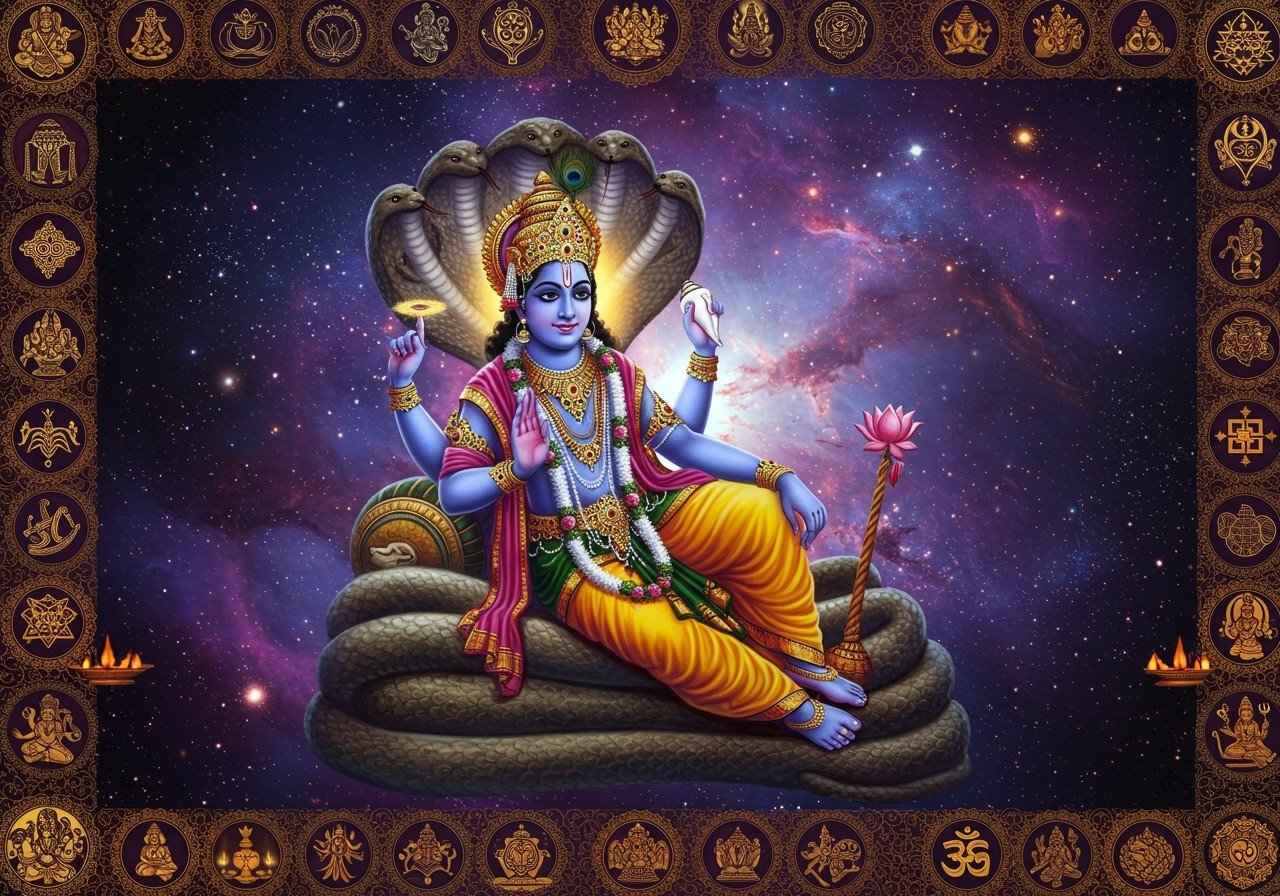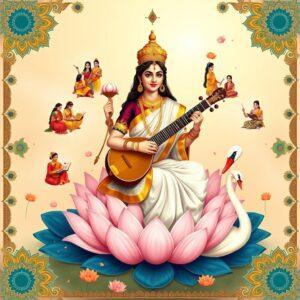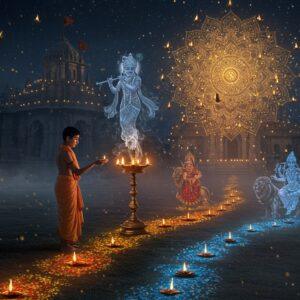
Hindu iconography, deeply rooted in ancient Vedic traditions, acts as a bridge between the spiritual and the artistic. These symbolic representations of deities and divine concepts aren’t just beautiful art; they reflect a rich cultural heritage. By understanding the Vedic foundations, we gain insight into how these symbols express profound religious meanings.
Introduction to the Vedic Roots of Hindu Symbolism
The ancient Vedic texts hold a key role in the development of Hindu iconography. The Vedas are the oldest sacred texts of Hinduism, providing the guiding principles that shape religious symbols. These texts, written during the Vedic period (around 1500-500 BCE), greatly influenced how divine figures are portrayed in art and architecture.
Iconography itself is essential to Hindu religious practices. It helps devotees connect with the divine through sacred images, known as ‘Murti’. Murtis are central to worship, offering a tangible form to abstract spiritual ideas. Understanding key terms like ‘Vedas’, ‘Murti’, and ‘Iconography’ helps us appreciate their importance in Hinduism.
Curious about Hindu philosophy? Delve deeper into the core concepts with our insightful guide: Hindu Philosophy Explained: A Beginner’s Guide.
The Vedic Influence on Hindu Religious Symbolism
Vedic scriptures laid the groundwork for Hindu iconography by defining divine characteristics. The Rigveda, Samaveda, Yajurveda, and Atharvaveda, each contributed to the depiction of gods and goddesses through hymns and mantras. These texts describe attributes that artists later used to create visual forms.
Vedic rituals also often involved symbolic objects, paving the way for later traditions. For example, ‘Yajna’ or fire rituals from the Vedic era are sometimes depicted in art, showing the transition from early Vedic deities to a more complex pantheon. Many symbols like the lotus, conch, and trident found in the Vedas are still prominent in Hindu iconography today.
Hindu Temple Iconography: A Vedic Perspective
Temples are not just structures; they are sacred spaces where Vedic rituals and iconography intertwine. The very architecture of temples often reflects Vedic cosmology and sacred geometry. Elements like the Mandala (cosmic diagram), Vimana (temple tower), and Garbhagriha (inner sanctum) symbolize spiritual concepts rooted in Vedic tradition.
The carvings and sculptures within temples frequently depict Vedic deities and scenes from mythology. Symbols like the lotus, chakra (divine disc), and kalasha (sacred pot) are often featured in the ornamentation, drawing directly from Vedic imagery. Even today, temple rituals and festivals still incorporate Vedic practices and artistic expression, creating a vibrant tapestry of tradition.
The Evolution of Hindu Symbolism
Hindu symbolism has come a long way from its Vedic beginnings. Concepts of divinity have evolved into the rich iconographic representations we see today. Local traditions and beliefs have also been woven into these representations, creating a diverse and vibrant spiritual tapestry.
To understand the significance of these symbols more deeply, exploring resources like “Hindu Symbols Explained: Their Meanings and Importance” can offer valuable insights. For a deeper dive into two specific symbols, you might find our article on “Rudraksha and Tulsi: Sacred Hindu Symbols Explained” enlightening.
Exploring Hindu Symbolism through Vedic Texts
The Vedas are revered in Hinduism, shaping its symbols and beliefs. These ancient texts are filled with hymns, rituals, and profound philosophical ideas. Many symbols we see in Hinduism today originate from these sacred writings.
Vedas as the Foundation
The Vedas, composed between 1500 and 500 BCE, are the oldest scriptures of Hinduism. They contain hymns and prayers that express spiritual truths, providing guidance for early rituals and giving rise to symbols used in worship. These texts act as the bedrock upon which many Hindu beliefs are built.
Symbolism and Allegory
Vedic texts often use allegory and metaphor to express abstract ideas. This imagery creates vivid representations of divine concepts, making complex spiritual themes more accessible. Through symbolism, the Vedas help followers grasp profound spiritual meanings.
The Oral Tradition’s Impact
For centuries, the Vedas were passed down orally before being written down in Sanskrit. This oral tradition highlights the importance of sound and recitation in conveying spiritual insights, demonstrating the power of the spoken word in preserving sacred knowledge. This practice ensured the continuity of these teachings across generations.
Vedic Language and Eternal Truths
Composed in Vedic Sanskrit, these texts are believed to contain eternal truths known as Sanatana Dharma. Many Hindus believe these truths were revealed to ancient sages, originating from a source beyond human history. This belief underscores the Vedas’ timeless wisdom. This adds a layer of sacredness and authority to the Vedic texts.
Symbolic Interpretations in Later Texts
The Brahmanas, Aranyakas, and Upanishads provide interpretations of Vedic mantras. These later texts delve into philosophical meanings and explore concepts like Brahman (the Absolute) and Atman (the individual self), building upon the foundations laid by the Vedas. They enhance our understanding of the core Vedic teachings.
Examples of Vedic Symbols
- Om: Represents creation, truth, and the origin of all Vedas. Its resonance is believed to encompass the entire universe, making it a powerful symbol in meditation and prayer.
- Swastika: A symbol of auspiciousness and well-being, its arms can represent various concepts. These include the four Vedas, four varnas (social classes), four ashrams (stages of life), or even the four directions. Its presence signifies positive energy and good fortune.
- Kalash and Deepak: Revered symbols, often used in rituals and ceremonies. The Kalash, a sacred pot, represents abundance and prosperity, while the Deepak, a lamp, symbolizes the dispelling of ignorance and the light of knowledge. Together, they embody Vedic Science and Culture.
Want to learn more about Yantras and Yagyas? Check out our informative article: Yantras and Yagyas Explained: A Beginner’s Guide.
Hidden Meanings
Vedic scriptures often use metaphors and symbolism to convey deeper truths, This symbolic or coded language allows for deeper levels of interpretation, enriching philosophical understanding. Unraveling these symbols adds to our appreciation of Hindu spirituality.
Connecting with Sacred Iconography through Poojn.in
At Poojn.in, we understand the importance of authentic items for worshipping Hindu deities and maintaining traditional iconographic practices. We make it easy to bring the sacred into your home.
We offer:
- High-quality brass Ganesha and Hanuman Murtis crafted by skilled artisans, meticulously following traditional guidelines. Each murti is imbued with spiritual significance.
- Complete puja sets containing all the necessary items for deity worship, ensuring you have everything you need for a reverent ceremony. Our sets simplify the process of performing pujas.
- Pure cotton vastras (deity clothing) in traditional colors and designs, adding a touch of elegance and respect to your worship. Dress your deities in beautiful attire that reflects devotion.
- Authentic sindoor, kumkum, and other items used in deity decoration. Enhance your worship with these traditional items.
- Brass and silver arti thalis for offering prayers and light. These beautifully crafted thalis add a touch of grace to your rituals.
- Traditional puja books with correct mantras and procedures, guiding you through each step of the worship process. Learn the proper way to perform pujas.
- Gomti Chakras and other sacred items to enhance your spiritual practice and create a positive ambiance in your home.
Our products help maintain the sacred bond between devotees and deities through proper iconographic worship. Each item at Poojn.in is carefully chosen to uphold traditional standards while being convenient for modern homes.
For personalized guidance on selecting the right items for your puja needs, please contact us:
- Phone: 03369029784
- WhatsApp: 9476142738
Visit www.poojn.in to explore our complete collection of authentic puja items and ritual supplies. We deliver across India with secure packaging to ensure your items arrive safely. You can also explore specific categories like Decoratives, Flammables, Holy Books and Holy Clothing.
Conclusion
Exploring the Vedic roots of Hindu iconography reveals a tapestry woven with deep spiritual insights and timeless wisdom. These symbols and imagery, born from the hymns and philosophies of the Vedas, connect our present with the rich traditions of the past. Each symbol, from the sacred Om to the auspicious Swastika, carries a story of divine truth and spiritual guidance. Rooted in tradition, these symbols continue to guide and inspire devotees, serving as reminders of the eternal truths of Sanatana Dharma. As these ancient symbols persist in modern rituals and practices, they invite us all to delve into the profound legacy of Hindu spirituality. Through understanding and reverence, we can appreciate the richness these symbols bring to our spiritual lives, offering a path to connect with the universe’s infinite wisdom.


